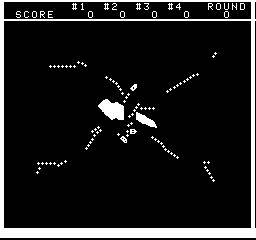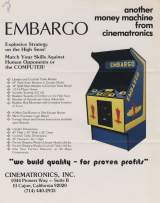
Embargo © 1977 Cinematronics.
Embargo is a one to four player blocking genre game. Each player must deposit a coin. There is a stylized map of Cuba (with a canal through the center) in the middle of the screen. There are four boats, one in each corner of the screen. If there were less than four players then the computer played the remainder. As the boats sail out they leave a continuous trail of mines behind. The players can control the direction and, with a single button, stop two mines from being laid in every twelve.
Each time a boat hits another boat, a mine, the screen edge or Cuba, it explodes and the surviving boats each get one point. This continues until zero or one boat is left. (If two boats collide they both blow up.) I believe there were four rounds per game. The strategy was to block off as much open water as you could while leaving a hole in your line of mines so you could double back and duck through it.

The display was a standard NTSC raster black-and-white monitor. The main logic board used a Signetics 2650 8-bit microprocessor chip.
The video timing was generated using TTL SSI synchronous counters and standard logic gates.
The sound board was separate from the main logic board. The explosion sound was based on a pseudo-random number generator which used a resistor ladder to generate something approximating white noise (although many thought it sounded like someone coughing). There was a single tone generator as well as gating logic, all controlled by the main logic board.
The four directional control knobs were encoded using standard 12 position make-before-break wafer switches that had the detent ball removed. Each had a matrix of diodes attached which generated a 4-bit Gray code.
Main CPU : S2650 (@ 625 Khz)
Screen orientation : Horizontal
Video resolution : 256 x 240 pixels
Screen refresh : 60.00 Hz
Palette Colors : 2
Players : 4
Control : dial
Buttons : 4 (1 for each player)
This was Cinematronics third game and first original game design. It took about 9 months from concept to production. The game was not a hit and only sold well in Florida. Space Wars was the next game and launched a golden age for the company.
Game Concept: Jim Pearce
Hardware & Software Design: Robert Shaver
Designer: Robert Shaver
Game's ROM.
Machine's picture.